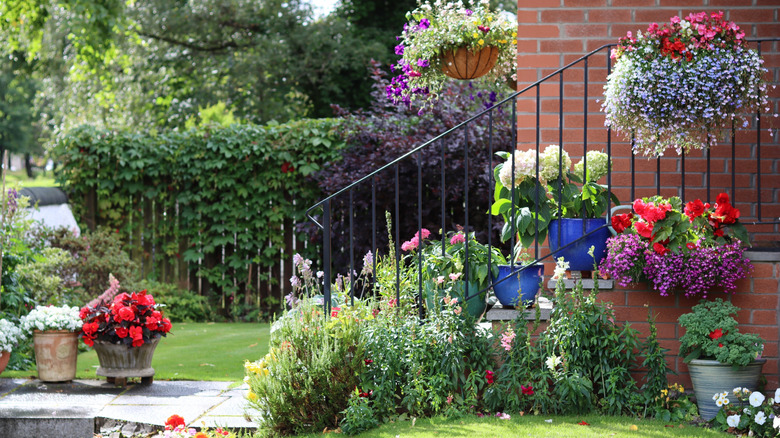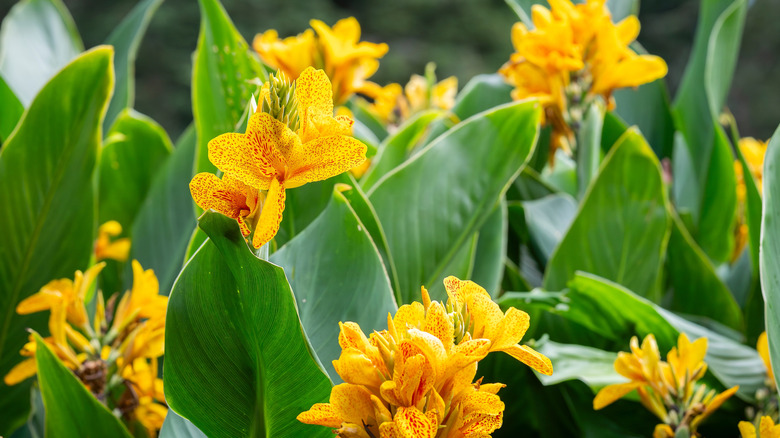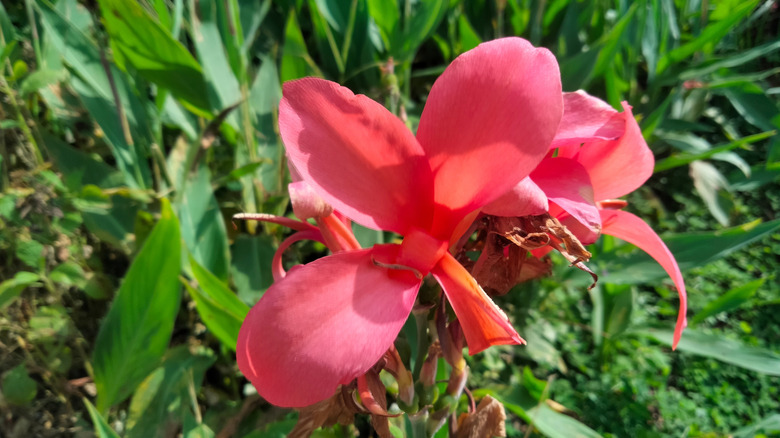The Flowering Perennial You Should Never Plant In Fall (& When To Do It Instead)
Perennials are a common favorite for beginning gardeners, because they only have to be planted once and they come back on their own each year. If you're just starting your gardening journey, planting perennials is a good way to get your hands dirty in the gardening world. While there are these 12 mistakes you want to avoid as a beginning gardener, you can learn to keep your perennials blooming longer with these must-know tips and tricks. One perennial that will add beautiful color to your garden is the canna lily (Canna x generalis). Canna lilies are bold, flowering plants that can reach heights of 6 feet or more, filling your garden with brilliant color that not only looks beautiful, but also attracts a host of pollinators, such as hummingbirds, and butterflies.
Cannas should not be planted in the fall, due to the fact that they do not handle cold temperatures and frost. They thrive in warm, humid conditions. You can plant canna lilies after winter once any danger of frost has passed and the soil is at least 60 degrees Fahrenheit. Canna lilies are typically grown as annuals in USDA Hardiness Zones 2 through 7, and perennials in Zones 8 to 10. These striking flowers are natives of tropical and sub-tropical areas in South and Central America, but with the proper growing conditions and protection (if needed), they can be grown anywhere. They are non-toxic and pet-friendly, so you don't have to worry about your cats, dogs, and horses being around them. Cannas will do the best when planted in late spring or early summer and will bloom from early to mid-summer, all the way until the first frost.
How to plant and care for your canna lily plants
For the best foliage color and bloom development, plant your cannas in areas of the garden or yard that get at least 6 to 8 hours of full sun each day. If you live in the southern part of the U.S. where the temperatures can become excessively hot, cannas will do better in locations that get full morning sun and afternoon shade, so the blooms don't get bleached out by the hot sun. Try to shelter your canna lilies with a fence or wall, so the large leaves are not torn apart by strong winds.
Soil preferences for cannas is rich, well-draining moist soil with neutral to slightly acidic pH levels. They can handle damper situations and do well along the edge of a pond or even in a rain garden. If all you have to work with is sandy or clay soils, you can add compost to the soil to improve it and make it suitable for your cannas. Once you plant the canna lilies, water them thoroughly. For best results water them once a week, soaking the base and roots with 1 to 2 inches of water each time and don't let the soil dry out completely. If the weather is particularly hot and dry, you can increase watering times to two or three times per week. If you have the canna lilies in containers, they will need to be watered more often than those planted in flower beds, since the soil dries out faster in containers.
Overwintering your canna lilies
Knowing how to keep your canna lilies happy during winter for beautiful spring blooms is the goal of any gardener that has this blooming plant in their garden. Overwintering properly for those Zones 6 and colder can prevent your cannas from being harmed during cold temperatures and frost. Dig up the rhizomes after the first frost, and cut the stems to just above the base. Rinse off the dirt and then let them dry thoroughly. Put peat moss in a garbage bag with a few holes poked in it and keep the rhizomes in there. Keep the bag in a cool spot that is around 50 degrees Fahrenheit or so. A basement or cellar is ideal.
Overwintering in Zone 7 is a little less intensive. After the first frost, cut the plant back until it is almost to the ground and then cover the entire crown with a layer of thick insulation, such as leaves or straw. Make sure there is enough covering to not blow away and leave the crown exposed. In regions 8 and above you don't need to do anything special to protect the cannas during the winter season, but you can spread a 3 inch layer of mulch or composted leaves over the crown for extra protection in case the temperatures drop. For cannas in containers, prune the dead material after the first frost and then you can bring the pots inside and keep them in a cool, dry place, like a basement or garage. You will not need to water them during the wintertime.


